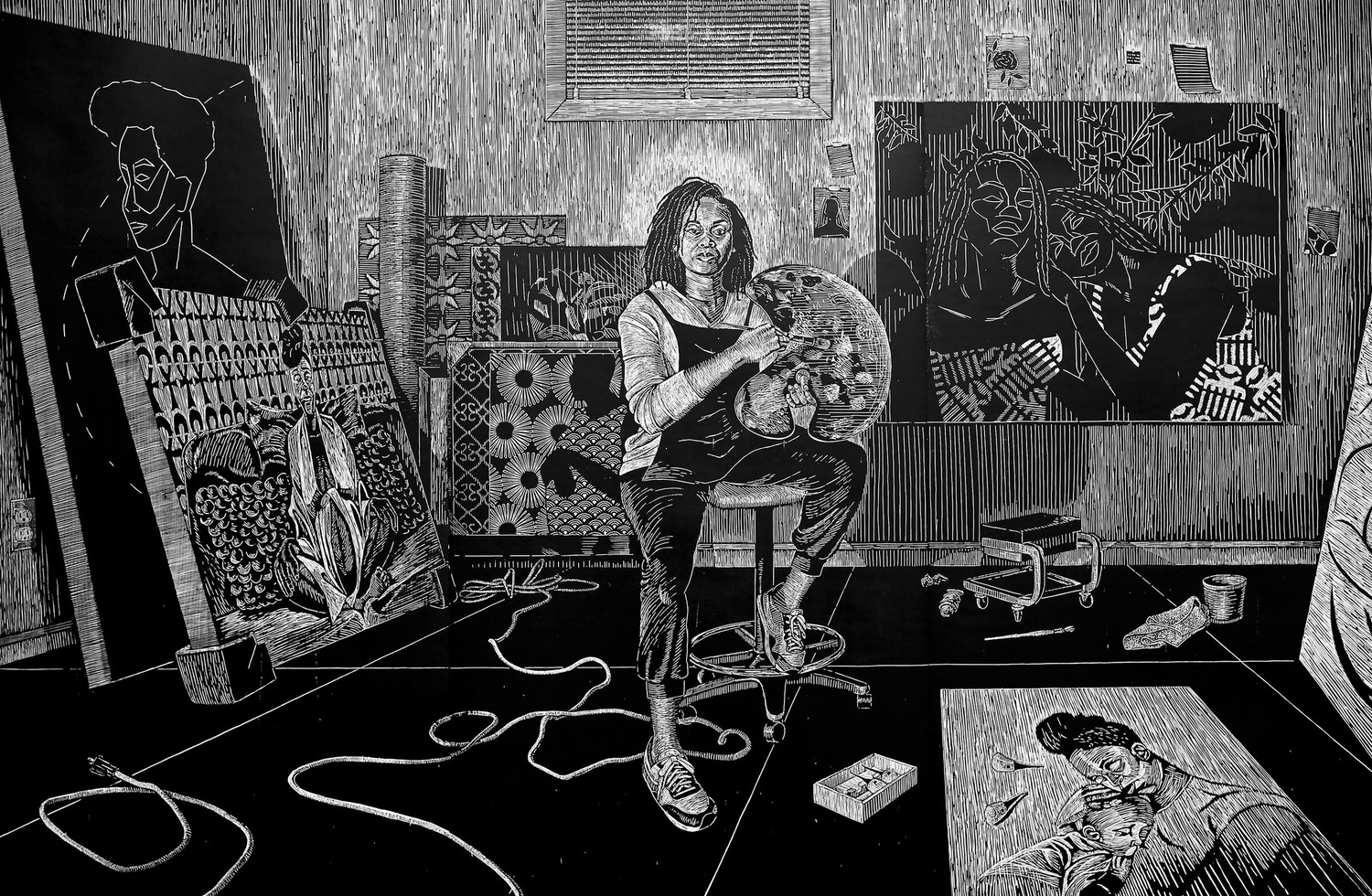
News
Progressive Labor Party Organizes Solidarity March With Harvard Yard Encampment

News
Encampment Protesters Briefly Raise 3 Palestinian Flags Over Harvard Yard

News
Mayor Wu Cancels Harvard Event After Affinity Groups Withdraw Over Emerson Encampment Police Response

News
Harvard Yard To Remain Indefinitely Closed Amid Encampment

News
HUPD Chief Says Harvard Yard Encampment is Peaceful, Defends Students’ Right to Protest
‘LaToya M. Hobbs: It’s Time’: A Monumental Negotiation of Time, Space, and Labor

“LaToya M. Hobbs: It’s Time” is the Harvard Art Museums’ latest exhibition this spring. Arkansas-born and Baltimore-based artist LaToya M. Hobbs presents her larger-than-life series of five woodcuts, “Carving Out Time,” each of them constructed as triptychs. This exhibition, curated by Carl A. Weyerhaeuser Curator of Prints Elizabeth M. Rudy with the help of Harvard students and the Association of Black Harvard Women, takes visitors on an intimate trip through a day in the life of Hobbs as she quite literally carves out time for the labor and responsibilities associated with balancing the roles of wife, mother, educator, and artist.
Depicting a day in Hobbs’s life with her family — husband Ariston Jacks and their two children, Ade and Theo — “Carving Out Time,” conceived in 2019 and created in 2020-2021, unfolds across five expansive scenes. Each piece measures 8 by 12 feet and consists of three closely aligned prints that collectively form an image in Hobbs’s day. The narrative progresses through scenes of the couple waking up to their two sons, engaging in work and play, sharing a family dinner, putting their children to bed, and concluding with Hobbs in her studio painting and printmaking. Scattered throughout the prints are other prominent Black artists who have influenced Hobbs’s career as an artist, including Kerry James Marshall, Margaret Burroughs, Elizabeth Catlett, and Valerie Maynard. This series of prints fosters an immersive and affective experience through its content and immensity that invites visitors to contemplate the intersections of time, space, and labor.
“Carving Out Time” is the climax of a larger ongoing project by Hobbs called “Salt of the Earth.” Inspired by the biblical scripture Matthew 5:13 that establishes humans as the “salt of the earth,” Hobbs explores the historical use of salt as a preserver and the preservative role that Black women adopt in their communities. This exhibition, then, is one that simultaneously evokes themes of personal identity and universality.
The fifteen panels are exhibited in succession along three adjacent walls. They are printed in black ink in contrast to the white space that represents the areas in the wood that Hobbs cut into. She uses dual-tonality to stunningly configure her light, shadows, and dimensions. The final print is a self-portrait — inspired heavily by “Untitled” by Kerry James Marshall — posed in her studio with a subtle halo behind her head. Hobbs first developed the halo as a provocative motif in her art as an undergraduate student, interrogating art historical traditions that associate the symbol solely with white people.
On the fourth wall in the gallery, Hobbs offers visitors a rare look at the six preparatory drawings that preceded the final prints. A little bit further down the same wall is a television featuring a never-before-seen video of the making of “Carving Out Time.” The show also includes a series of prompts to initiate reflection and conversation, inviting visitors of all ages to engage with the installation through its activity guides designed for younger audiences. These guides are meant to be taken and used in the gallery, with some asking visitors to try and spot certain items in the prints. The exhibition is clear in its request for the participation and deliberation of all audiences.
In placing her thematic exploration of labor in conversation with her use of woodcutting, Hobbs essentializes the medium of printmaking. The manually laborious process of relief printing involves not only hand-carving into the wood but also inking its sizeable surfaces and utilizing the optimum pressure to successfully transfer the ink evenly onto paper, which Hobbs achieved in collaboration with printers from BIG INK.
To Hobbs, the matrix — in this case, the surface of the woodblocks from which the prints were made — is valued at an equal level in artistic status as the prints themselves, if not more so. The suite of prints at the Harvard Art Museums is just one part of Hobbs’s artwork — the other one being the carved woodblocks themselves, which have been shown previously at the Baltimore Museum of Art and are currently on display at the Frist Art Museum in Nashville. Hobbs is especially fond of subverting expectations of the art object by elevating the print matrix as art itself — she identifies the prints as secondary to the wood panels, which were originally meant to be the primary works of art.
This inverted conception of objecthood is consistent with Hobbs’s practice as a printmaker. Whereas it is common practice for artists to be particularly aware of the concept of reversal in their prints, Hobbs looks further still. Her prioritization of the matrix meant that she constructed her images as is on the wood, and therefore did not mind the works being in reverse when transferred onto paper. Hobbs’s approach is very much aligned with her identity as a painter as well, which she does little to disentangle from her identity as a printmaker. She generally does not differentiate between the construction of paint and print and thus often works as a multimedia artist, synthesizing both of her practices.
“LaToya M. Hobbs: It’s Time” is an intricate consideration of concepts we often take for granted. It is a remarkable creation that consciously makes visible the otherwise invisible complexities of navigating different roles that each have distinctive responsibilities but are at once inextricable from one another.
The exhibition will be on view until July 21 on the 3rd floor of the Harvard Art Museums in the Special Exhibitions Gallery.
Want to keep up with breaking news? Subscribe to our email newsletter.
